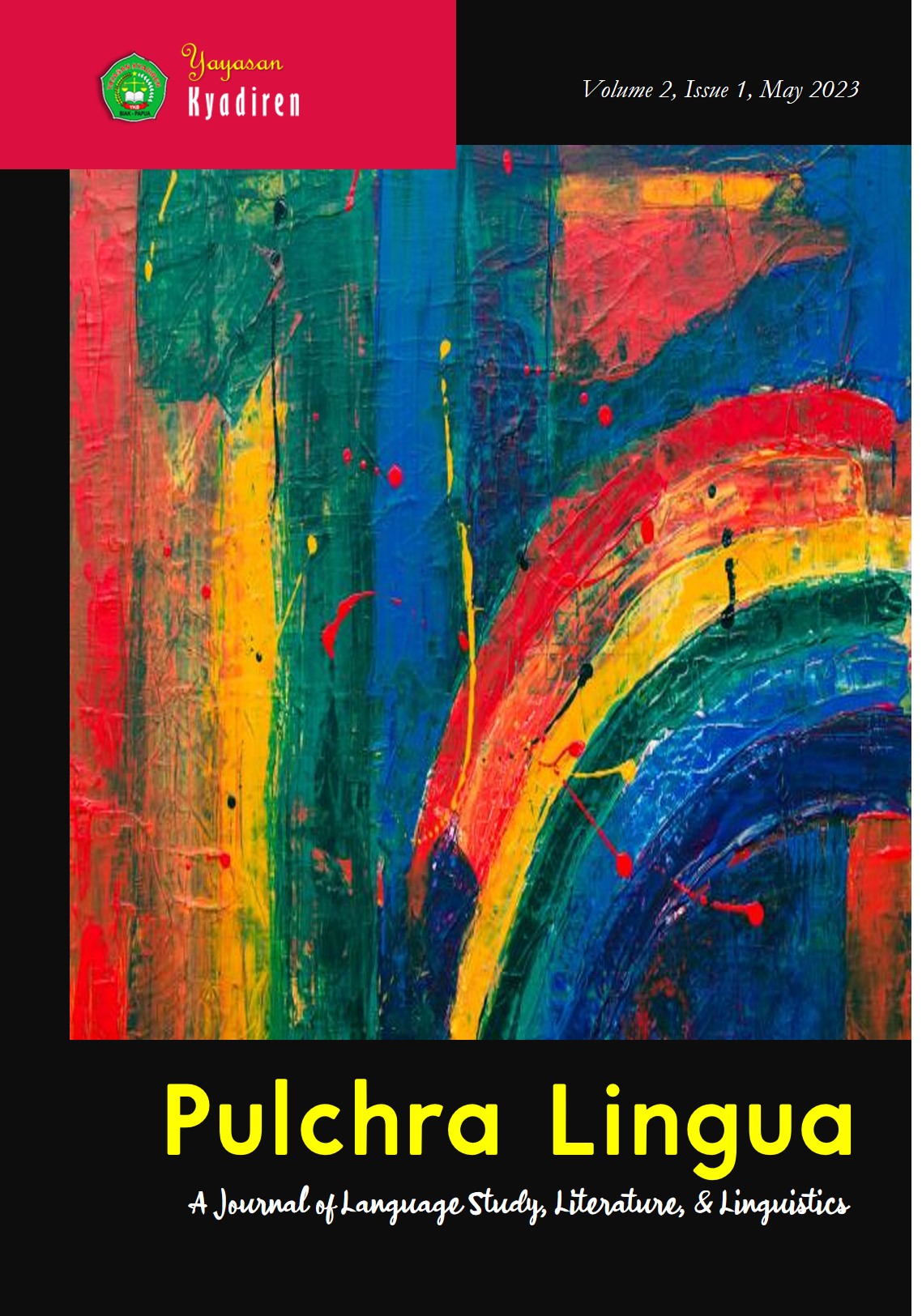The Efficacy of English Phonics Instruction in Helping EFL Students to Decode Vowel Digraph Letters
DOI:
https://doi.org/10.58989/plj.v2i1.20Keywords:
EFL, Efficacy, Phonics, Phonetics, Vowel DigraphAbstract
The current study aimed to disclose how effective Phonics instruction is in increasing speech accuracy and glimpsing at students' perspectives on phonics learning in the classroom. This study applied quasi-experimental research involving 30 Department of Literature students learning English as a foreign language. The researcher also used the questionnaire to glimpse their perspective on phonics instruction. This study discovered that phonics learning significantly improved pronunciation accuracy and the ability to decode vowel digraph <ai>. In addition, students also have a positive view of phonics learning, which is one of the important materials at the beginning of the introduction of foreign language systems which helps them produce accurate utterances and helps improve literacy. The current study considers that phonics instruction needs to get important attention to become a solution to student learning problems.
References
Journals
Altmiller, R., Treiman, R., & Kessler, B. (2023). Double Trouble: Using Spellings of Different Lengths to Represent Vowel Length in English. Journal of Experimental Child Psychology, 231. https://doi.org/10.1016/j.jecp.2023.105649
Bizzocchi, A. L. (2017). How Many Phonemes Does the English Language Have? International Journal on Studies in English Language and Literature, 5(10), 36–46. https://www.arcjournals.org/international-journal-on-studies-in-english-language-and-literature/volume-5-issue-10/6
Brooks, G. (2022). Current Debates Over the Teaching of Phonics. Education. https://doi.org/10.1093/acrefore/9780190264093.013.1543
Connelly, V., Johnston, R., & Thompson, G. B. (2001). The Effect of Phonics Instruction on The Reading Comprehension of Beginning Readers. Reading and Writing, 14, 423–457. https://doi.org/10.1023/A:1011114724881
Daniarti, Y., Taufiq, R., & Sunaryo, B. (2020). The Implementation of Teaching Reading Through Genre Based Approach for University Students. Journal of Physics Conference Series, 1477(4), 1–6. http://dx.doi.org/10.1088/1742-6596/1477/4/042064
Dirgeyasa, I. W. (2016). Genre-Based Approach: What and How to Teach and to Learn Writing. English Language Teaching, 9(9), 45–51. https://doi.org/10.5539/elt.v9n9p45
Ehri, L. C. (2022). What Teachers Need to Know and Do to Teach Letter–Sounds, Phonemic Awareness, Word Reading, and Phonics. The Reading Teacher, 76(1), 53–61. https://doi.org/10.1002/trtr.2095
Ehri, L. C., Nunes, S. R., Stahl, S. A., & Willows, D. M. (2001). Systematic Phonics Instruction Helps Students Learn to Read: Evidence from The National Reading Panel’s Meta-Analysis. Review of Educational Research, 71(3), 393–447. https://doi.org/10.3102/00346543071003393
Indrayadi, T., Daflizar, D., Irawan, Y., & Helty, H. (2021). Indonesian EFL Students’ Difficulties in Recognizing English Letters. The Qualitative Report, 26(11), 3476–3491. https://doi.org/10.46743/2160-3715/2021.4846
Kang, Y., & Liang, L. (2018). The Effect of EFL Teachers’ Training in Rural West China: Evidence From Phonics-oriented Program. English Language Teaching, 11(3), 40–49. http://dx.doi.org/10.5539/elt.v11n3p40
Manullang, R. A., Sianipar, E., Herman, H., & Sinurat, B. (2022). The Application of Phonics Instruction in Reading Text at Grade X SMK N. 1 Pematangsiantar. Periodica Journal of Modern Philosophy, Social Sciences and Humanities, 4, 25–31. https://www.periodica.org/index.php/journal/article/view/43
Martínez, Á. M. (2011). Explicit and Differentiated Phonics Instruction as a Tool to Improve Literacy Skills for Children Learning English as a Foreign Language. GIST Education and Learning Research Journal, 5, 25–49. https://latinjournal.org/index.php/gist/article/view/595
Mesmer, H. A. E., & Griffith, P. L. (2005). Everybody’s selling it—But just what is explicit, systematic phonics instruction? The Reading Teacher, 59(4), 366–376. http://dx.doi.org/10.1598/RT.59.4.6
Sanden, S., MacPhee, D. A., Hartle, L., Poggendorf, S., & Zuiderveen, C. (2022). The Status of Phonics Instruction: Learning from the Teachers. Reading Horizons: A Journal of Literacy and Language Arts, 61(1), 69–92. https://scholarworks.wmich.edu/reading_horizons/vol61/iss1/5/
Savitri, N. A., & Andrianto, F. (2021). Preferences and Attitude toward English Phonetics Learning: The perspectives of Indonesian EFL Learners. Educafl: Journal of Education of English as Foreign Language, 4(1), 52–57. https://doi.org/10.21776/ub.educafl.2021.004.01.06
Utami, S., & Musthafa, B. (2022). The Utilization of Phonics Songs in Phonics Reading Classes in Indonesia: Teachers’ Perspectives. Jurnal Pendidikan Bahasa dan Sastra, 22(2), 201–208. https://doi.org/10.17509/bs_jpbsp.v22i2.55911
Woore, R. (2022). What Can Second Language Acquisition Research Tell Us About the Phonics ‘Pillar’? The Language Learning Journal, 50(2), 172–185. https://doi.org/10.1080/09571736.2022.2045683
Proceedings
Gozali, I. (2019). Developing Phonics Material to Improve the Spoken English of Indonesian Tertiary Students. ISoLEC: International Seminar on Language, Education, and Culture, 379–387. https://doi.org/10.18502/kss.v3i10.3920
Thesis
Li, S. (2019). The Effects of Phonics Instruction on L2 Phonological Decoding and Vocabulary Learning: an Experimental Trial on Chinese University EFL Learners [University of Oxford]. https://ora.ox.ac.uk/objects/uuid:cc933e16-3226-4e62-b859-77c4f32ccc1d
Books
Strickland, D. S. (1998). Teaching Phonics Today: A Primer for Educators. International Reading Association.
Tunmer, W. E., & Arrow, A. W. (2012). Reading: Phonics Instruction. In J. Hattie & E. M. Anderman (Eds.), International Guide to Student Achievement (1st ed., pp. 131–141). Routledge, Taylor & Francis. https://doi.org/10.4324/9780203850398
Downloads
Published
How to Cite
Issue
Section
License
Copyright (c) 2023 Rizky Anugrah Putra

This work is licensed under a Creative Commons Attribution-ShareAlike 4.0 International License.






